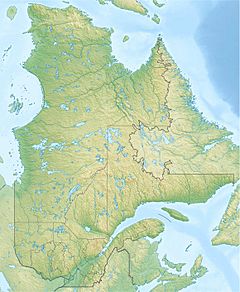Schmon River facts for kids
The Schmon River (which is called Rivière Schmon in French) is a river in the Côte-Nord region of Quebec, Canada. It flows south and empties into a large body of water called Lake Walker.
Quick facts for kids Schmon River |
|
|---|---|
| Native name | Rivière Schmon |
| Country | Canada |
| Province | Quebec |
| Region | Côte-Nord |
| Physical characteristics | |
| River mouth | Lake Walker 117 metres (384 ft) 50°25′20″N 67°11′32″W / 50.42222°N 67.19222°W |
| Length | 90 kilometres (56 mi) |
| Basin features | |
| Basin size | 928.2 square kilometres (358.4 sq mi) |
Contents
Where is the Schmon River Located?
The Schmon River starts in two lakes: Lac au Vent and Lac aux Mouches. It flows south for about 90 kilometers (56 miles). The river ends when it flows into Lake Walker. This spot is about 117 meters (384 feet) above sea level.
Most of the river flows through the Port-Cartier–Sept-Îles Wildlife Reserve. This is a protected area for animals and nature. The last part of the river goes through an area that might become the Lake Walker National Park. The land around the Schmon River is mostly covered with evergreen forests.
How the Schmon River Got its Name
Before 1975, the river had a different name: Rivière aux Rochers Nord-Ouest. It was renamed to honor Arthur A. Schmon. He was an important person in the paper industry. He lived from 1895 to 1964 and was from Newark, New Jersey. The river also flows through a lake called Lake Schmon near its beginning.
The River's Journey and Surroundings
The Schmon River is one of the main rivers that feed into Lake Walker. The area of land that drains into the river, called its watershed, covers about 928.2 square kilometers (358.4 square miles). This area stretches about 79 kilometers (49 miles) upstream from the lake.
Long ago, glaciers moved through this valley many times. These huge ice sheets changed the valley from a V-shape to a deeper, U-shaped trough. Along its path, the Schmon River valley has areas where glaciers left behind barriers and basins. For example, the valley gets much wider south of the Saint-Joseph Creek.
In the last 20 kilometers (12 miles) of the river, you can see many bends. These bends are called meanders. They show where the river has changed its path over time. Melted ice from glaciers carried sand and gravel into this valley. Over time, the river moved these materials downstream. The land next to the river has high, flat areas called terraces. Below these, there are lower terraces closer to the river.
Climate and Environment Around the River
The area around the Schmon River has a cold climate. It is known as a boreal climate zone. The average temperature for the year is about -1 degree Celsius (30 degrees Fahrenheit). July is the warmest month, with an average temperature of 14 degrees Celsius (57 degrees Fahrenheit). February is the coldest month, with an average of -16 degrees Celsius (3 degrees Fahrenheit).
Maps of Quebec's natural regions show that the river starts and flows through a part of the boreal zone. This area is known for its eastern spruce trees and moss.


